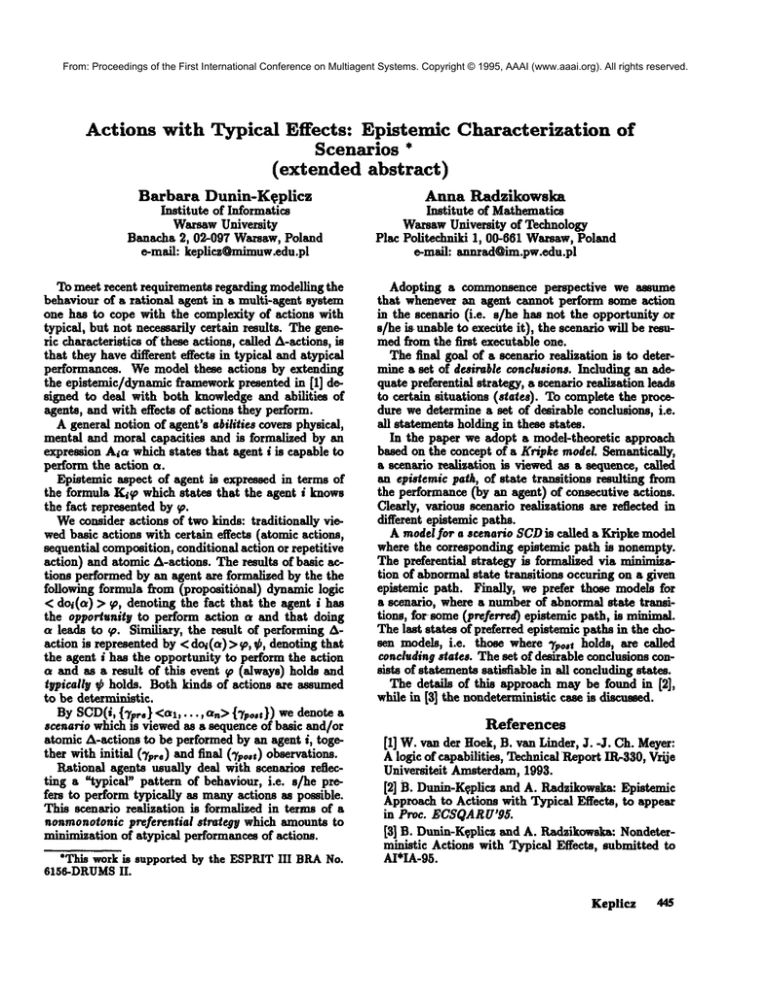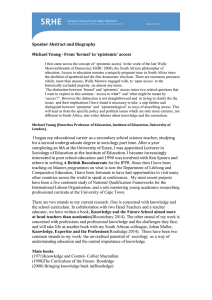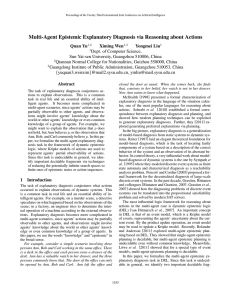
From: Proceedings of the First International Conference on Multiagent Systems. Copyright © 1995, AAAI (www.aaai.org). All rights reserved.
Actions with Typical Effects: Epistemic Characterization
Scenarios *
(extended abstract)
Barbara
Dunin-Keplicz
Institute of Informatics
WarsawUniversity
Banacha 2, 02-097 Warsaw,Poland
e-mail: keplicz@mlmuw.edu.pl
To meet recent requirements regarding modelling the
behaviourof a rational agent in a multi-agent system
one has to cope with the complexity of actions with
typical, but not necessarily certain results. Thegeneric characteristics of these actions, called ~,-actions, is
that they havedifferent effects in typical and atypical
performances. Wemodel these actions by extending
the epistemic/dynamicframeworkpresented in [1] designed to deal with both knowledgeand abilities of
agents, and with effects of actions they perform.
Ageneral notion of agent’s abilities coversphysical,
mental and moral capacities and is formalized by an
expression Aia whichstates that agent i is capable to
perform the action a.
Epistemic aspect of agent is expressed in terms of
the formula K~which states that the agent i knows
the fact represented by ~.
Weconsider actions of two kinds: traditionally viewedbasic actions with certain effects (atomic actions,
sequential composition,conditional action or repetitive
action) and atomic ~-actions. Theresults of basic actions performedby an agent are formalized by the the
following formula from (propositional) dynamiclogic
< doi(a) > ~, denoting the fact that the agent i has
the opportenity to perform action a and that doing
leads to ~. Simillary, the result of performing ~action is represented by < d~(a) > ~o, ¢, denoting that
the agent i has the opportunity to perform the action
a and as a result of this event ~ (always) holds and
t~/pically ~ holds. Both kinds of actions are assumed
to be deterministic.
By SCD(i, (Tpr,} <al,..., an> {Tp..,})
wedenote a
scenar/o whichis viewedas a sequenceof basic and/or
atomic A-actions to be performedby an agent i, together with initial (Tpre) and final (Tpo,,) observations.
Rational agents usually deal with scenarios rellecting a ~typical" pattern of behaviour, i.e. s/he prefers to performtypically as manyactions as possible.
This scenario realization is formalized in terms of a
nonmonotonicpreferential strategy which amountsto
minimizationof atypical performancesof actions.
*This work is supported by the ESPRITIII BRANo.
6156-DRUMS
II.
of
Anna Radzikowska
Institute of Mathematics
WarsawUniversity of Technology
Plac Politechniki 1, 00-661Warsaw,Poland
e-mall: annrad@im.pw.edu.pl
Adopting a commonsenceperspective we assume
that whenever an agent cannot perform some action
in the scenario (i.e. s/he has not the opportunity or
s/he isunable to execizte it), the scenario will be resumedfrom the first executable one.
Thefinal goal of a scenario realization is to determinea set of desirable conclwsions. Including an adequatepreferential strategy, a scenario realization leads
to certain situations (states). To completethe procedure wedeterminea set of desirable conclusions~i.e.
all statements holding in these states.
In the paper we adopt a model-theoretic approach
based on the concept of a Kripke model. Semantically,
a scenario realization is viewedas a sequence, called
an epistemie path, of state transitions resulting from
the performance(by an agent) of consecutive actions.
Clearly, various scenario realizations are reflected in
different epistemicpaths.
A model.for a scenario SCDIScalled a Kripke model
wherethe corresponding epistemic path is nonempty.
The preferential strategy is form~l|zed via minimization of abnormalstate transitions occuring on a given
epistemic path. Finally, we prefer those modelsfor
a scenario, wherea numberof abnormalstate transitions, for some(preferred) epistemic path, is minimal.
Thelast states of preferred epistemicpaths in the chosen models, i.e. those where7pos: holds, are called
concludin9statea. Theset of desirable conclusionsconsists of statementssatisfiable in all concludingstates.
The detA|lA of this approach maybe found in [2],
while in [3] the nondeterministiccase is discussed.
References
[1] W.van der Hoek,B. van Linder, J. -J. Ch. Meyer:
Alogic of capabilities, TechnicalReportIR-330, Vdje
Universiteit Amsterdam,1993.
[2] B. Dunin-Kcpllczand A. Radzikowska:Epistemic
Approachto Actions with Typical Effects, to appear
in Proc. ECgQARU’95.
[3] B. Dunin-K~pliczand A. l~dzikowska: Nondeterministic Actions with Typical Effects, submitted to
AI*IA-95.
Keplicz
445





